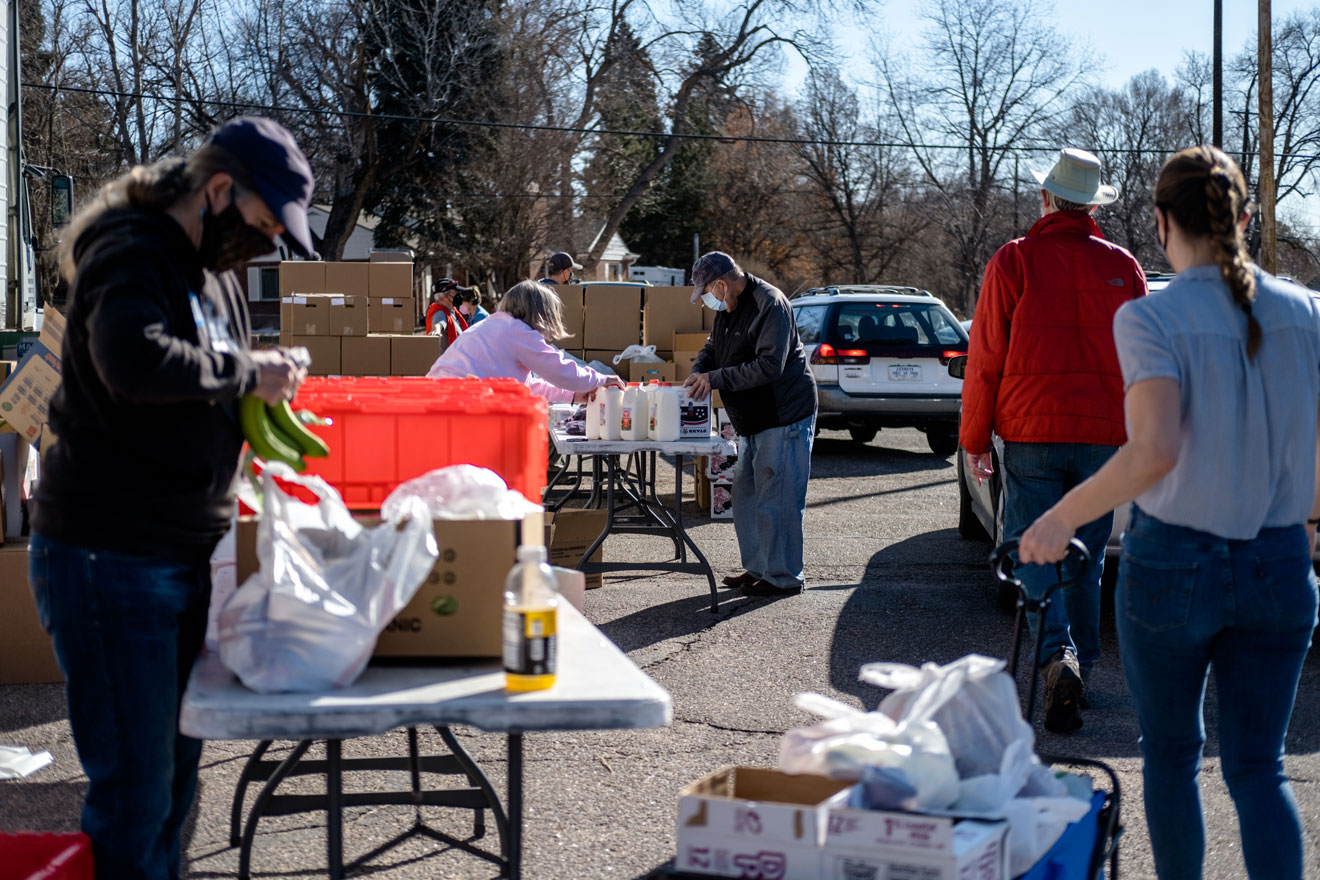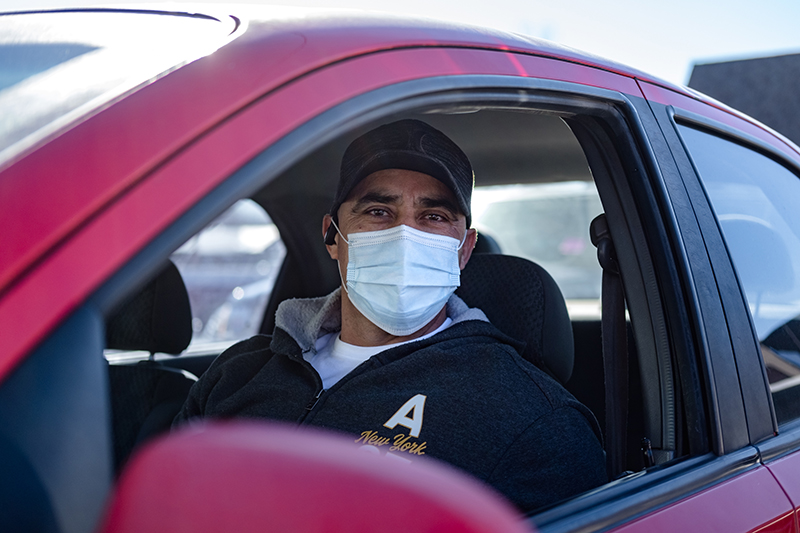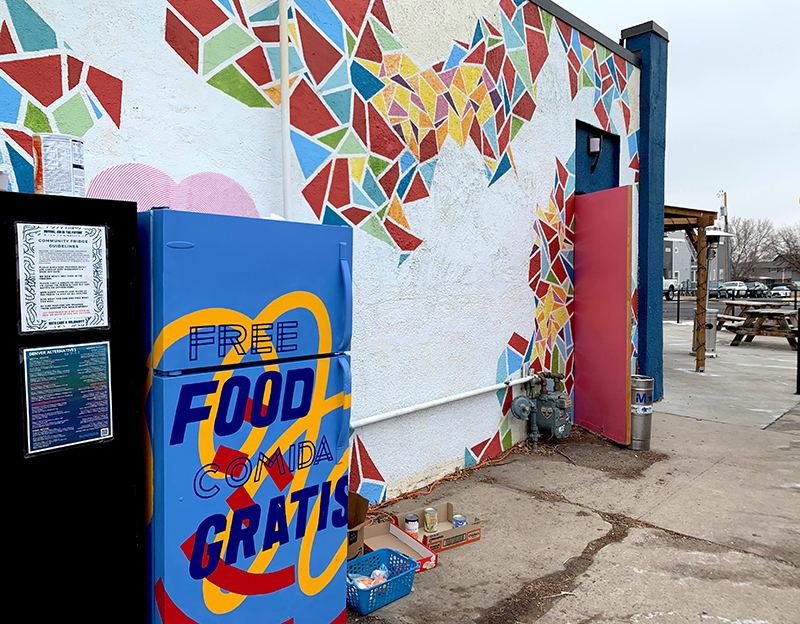
Volunteers package food for pickup during a Food Bank of the Rockies mobile pantry at St. Paul’s Episcopal Church in Lakewood, Colo. on March 3, 2021. Photo by Eli Imadali
Volunteers package food for pickup during a Food Bank of the Rockies mobile pantry at St. Paul’s Episcopal Church in Lakewood, Colo. on March 3, 2021. Photo by Eli Imadali
Pallets holding oversized boxes of food are lined up in the parking lot at St. Paul’s Episcopal Church in Lakewood on a 26-degree February morning. Nearly a dozen cars wait in parking spots. More drive in every couple of minutes.
One by one, volunteers call them forward—numbered, orange sticky notes are placed on their windshields as they arrive to keep things orderly—and load cartons full of bread, canned goods, frozen chicken, apples, potatoes and other food into open trunks before moving on to the next vehicle.
Food Bank of the Rockies has operated this mobile pantry since June, and it’s always busy. It’s one of approximately 80 such food distributions the nonprofit hosts each month. This one is held from 9-11 a.m. on the first and third Wednesday of the month and serves around 100 families each time.
Reggie’s white van is marked with number 41. (She requested that we not use her last name.) A theater stagehand, she’s been unemployed since March 2020. She picks up food for her own family once a month or so—her husband is a semi-retired hairdresser—and shares any extra goods with their next-door neighbors who are on a fixed income. She tries to limit her visits based on her family’s situation, which can vary from week to week.
“I refuse to take advantage of the situation if other people are in greater need,” she says, her blue eyes tearing up under a gray beret. But the food bank is “crucial,” she says. “It’s a lifeline, especially for those folks who might not qualify for food stamps.” Though Reggie and her husband are receiving unemployment, their budget is “extremely tight,” and their house is in forbearance.
Today, Reggie is not braving the cold for herself; she’s here to help a couple of colleagues who recently ran out of food and don’t have easy access to transportation. Shortly after she drives through the pickup line, a volunteer walks over to tell the site coordinator that there is only enough food left for seven families. It’s not yet 9:30 a.m.
* * *
Lack of access to enough nutritious sustenance—referred to as food insecurity—is not a new problem. Rather, COVID-19 amplified already existing disparities as it did with myriad other public and social health issues. In Colorado, food insecurity “has gone up somewhere between three- and fourfold,” says Brett Reeder, director of client services at Hunger Free Colorado. “Folks are really struggling.”
The statewide nonprofit has been administering quarterly surveys since June 2020. In its most recent, in December, a staggering 38% of respondents self-reported as food insecure. That marked the highest rate since the survey began—and nearly double rates during the Great Recession. The statistics were already too high pre-pandemic, with one in 10 Coloradans (and one in six children) experiencing food insecurity. Hunger Free Colorado embraces broad considerations when evaluating food insecurity, including whether people are able to reliably access and afford food as well as the quality and variety of available ingredients.
“When we’re talking about one of the wealthiest states in one of the wealthiest nations in the world, that’s an unacceptable level,” says Erin Ulric, implementation director for the Colorado Blueprint to End Hunger, the state’s five-year-plan. “What we’ve seen with COVID is beyond our wildest nightmares. We’re talking about a tripling of a rate that was unacceptable to begin with.”
The U.S. Census Bureau hasn’t found levels to be quite as high, though it relies on a slightly different metric. Its Household Pulse Survey measures food sufficiency in the previous seven days. In its most recent accounting, collected during a 13-day window at the end of January, nearly 10% of responding Colorado households, and about 11% nationally, either “sometimes” or “often” did not have enough to eat during the week prior.
That’s in line with the U.S. Department of Agriculture’s pre-pandemic 2019 data, which used a broader definition (lacking “access to enough food for an active, healthy life for all household members”) in estimating that 10.5% of U.S. households were food insecure.
“There are a variety of definitions, a variety of measures, a variety of metrics,” which makes precise data collection difficult, acknowledges Hunger Free Colorado’s Reeder. But, he says, “By most measures, [food insecurity] has gone up and, in some cases, quite a bit… It’s worse than we’re used to seeing.”
The economic fallout from the pandemic aside, food prices may also be a factor: The USDA found that food prices at grocery stores rose 3.7% between January 2020 and January 2021.
Food Bank of the Rockies, which serves 30 Colorado counties and all of Wyoming, is distributing around 60% more food every month than the organization was pre-pandemic. For this fiscal year, which ends in June, they anticipate distributing 40 million additional pounds of food compared to the year prior.
The organization and its partners are also seeing more new clients: “Approximately 40% of the people we are serving have never needed help with food assistance before now,” says CEO Erin Pulling.

Pilar Caro waits in line at the Food Bank of the Rockies mobile pantry in Lakewood. It was Caro’s second time getting food from the mobile pantry. Photo by Eli Imadali
While Pulling has detected increased need throughout the organization’s coverage zone, she says some of Colorado’s hardest-hit communities are on the Western Slope, particularly mountain communities and ski towns where jobs are often seasonal and already tenuous. “Some mobile pantries in mountain communities, especially in the Aspen area, have quadrupled [their need],” she says.
In southern Colorado—another region of concern—three Centura Health hospitals have stepped in as access points, partnering with Care and Share Food Bank to act as food pantries for patients and staff in Colorado Springs, Cañon City and Pueblo. (The three counties these cities are located in were projected to see food insecurity increase by nearly a third compared to 2018, according to estimates from Feeding America.) The Centura locations are distributing between 100 and 400 25-pound boxes of food (much of it from the USDA’s Farmers to Families program) each week depending on the location. Christi-Marie Butler, Centura’s group director of philanthropic strategy and operations, said she began to grasp the enormity of food insecurity when she saw the cars lining up on distribution days and heard one employee after another saying, “I’m the only breadwinner in my family right now” or “Me and my neighbor split this because we don’t have easy access [to food].”
“We have an essential role,” Butler adds. “You cannot get serious about health if you don’t look at food, and you cannot get serious about food if you don’t use hospitals… This is the work that could substantively affect community health.”
* * *
Poverty and unemployment are key indicators of food insecurity, and the unemployment rate in Colorado is hovering above 8%—the highest it has been since June 2020. Technical issues with the launch of Colorado’s new unemployment system in January and delayed extensions of federal benefits programs have left many people in a lurch, running out of money or food before their next checks arrive.
“Hunger doesn’t have one story. It doesn’t impact one type of person,” says Joanna Wise, Care and Share’s marketing and communications director. “There isn’t one situation that spurs food insecurity.”
Which is why people need a variety of ways to fill their fridges and bellies. Throughout the pandemic, community-level initiatives have stepped in to help bridge service gaps.
Starting in early December, brightly painted refrigerators offering free food began popping up outside small businesses across Denver. Individuals in need can walk, bike or drive up to the six fridges currently in service and grab fresh fruits and vegetables, premade meals (from commercial kitchens), and even baby food. Repurposed filing cabinets serve as pantries, stocked with nonperishables and toiletries. Most of the sustenance is donated anonymously by community members.
Denver Community Fridges (DCF) is the brainchild of 24-year-old Eli Zain, who was inspired by similar mutual aid projects in metro areas from New York City to Los Angeles.
“We want to put them in high-traffic areas where people will be able to easily and visibly see where the fridges are and what they are,” Zain says. “It makes it really hard to ignore food insecurity in your direct community.”
Volunteers and DCF staff keep the fridges clean and alert the neighborhood, often via Instagram, when supplies are running low.
“There should be no privilege required to have decent access to food,” says Huckleberry Roasters founder and owner Koan Goedman. The coffee shop’s location in Denver’s Sunnyside neighborhood has hosted a community fridge for more than two months; the shop supplies the electricity to keep it running. “[The community fridges are] not viewed through a prism of charity. This is really about people being cared for by members of the community who see that there’s a need.”

The community fridge outside Huckleberry Rosters in the Sunnyside neighborhood of Denver. Photo by Daliah Singer
Because the service is contactless, Zain doesn’t have data to share but notes that the fridges are “stocked to the brim by 11 or noon usually every single day” and then emptied out again by the next morning. “[It gives people] agency over what they eat,” Zain says.
DCF hopes to add additional locations in neighborhoods in need, including West Colfax and Capitol Hill, in the near future. Others are looking into starting similar efforts in Boulder and Englewood.
Also in December, the downtown jazz club Dazzle Denver, with the help of some partners, launched Bread & Jam, a combination livestream session (a paid gig for the performing band), support forum and free food pantry for local musicians that operates Fridays through Sundays.
“I know of people firsthand who were eating an apple for breakfast and nothing else until dinner—getting by on one meal a day,” says Cass Clayton, a soul-rock singer who is volunteering with the effort.
In the back room at Dazzle, musicians and industry peers can stock up on nonperishable goods, sturdy vegetables and toiletries. (Donations can be dropped off on weekends.) “We want musicians to know that your cupboard doesn’t have to be bare to stop in,” Clayton says. “We want people to be able to divert their finances and pay their electric bill or buy their kid a birthday gift.”
These grassroots solutions are beneficial, but they’re stopgap answers because they’re limited in their reach. Bread & Jam, for example, is assisting 30-40 people each week. In comparison, the federal Supplemental Nutrition Assistance Program (SNAP, formerly known as food stamps) serves more than 250,000 Colorado households.
“SNAP is by far the biggest, most responsive solution,” Hunger Free Colorado’s Reeder says. “Prior to the pandemic, roughly nine times more food was given to folks through SNAP than the Feeding America network [of food banks].”
Colorado has opted into maximum SNAP benefit allotments during the pandemic, but the program comes with its own challenges: The state has the 44th lowest SNAP enrollment ranking in the country, according to the Colorado Blueprint report. More than one-third of residents experiencing food insecurity earn too much to qualify for SNAP or the related Special Supplemental Nutrition Program for Women, Infants, and Children (WIC); the cap for a mother of two to access SNAP is a gross income of $28,236. Colorado’s high cost of living also means the money SNAP provides doesn’t stretch as far. Additionally, people who are undocumented are, for the most part, ineligible for the government program (it’s estimated that there are nearly 200,000 undocumented immigrants in Colorado) and need to look for help elsewhere.
To have food reach some of those underserved communities, the Blueprint created the Colorado COVID-19 Emergency Hunger Relief Fund; so far, around $5.2 million has been granted to community-based organizations. Another, potentially final, round of grants is expected to open soon.
Together, this collection of programs and initiatives fashion a network of care for those struggling to have enough to eat. “It’s about more than food,” says Care and Share’s Wise. “When we’re able to provide food, we’re also to be able to provide hope and relief and a sense of normalcy for people where they don’t have to stress and worry about how they’re going to be able to afford groceries and provide food to their families.”
* * *
Food insecurity doesn’t seep equally into communities. Though access to food can be difficult for many groups—people experiencing homelessness and the housed, those with jobs and those without, singles and families—communities of color bear the stress of hunger more acutely. (It’s worth noting that these populations are already experiencing higher COVID-19 mortality rates and have been hardest hit by the economic repercussions of ongoing business closures.) According to Hunger Free Colorado’s December 2020 survey, 52% of nonwhite and Latinx people are facing food insecurity, compared to 30% of whites. “The disparities are not only there, but bigger than they were before,” Reeder says.
Families with children are also disproportionately struggling. Without in-person school to share the burden of some meals—in 2019, more than 371,000 Colorado students qualified for free or reduced-price school lunches—a growing number of parents are being forced to make impossible choices between buying groceries, paying the utility bills and covering rent for the month. Though school districts and the state and federal government stepped up to continue providing meals during the transition to virtual learning, there are health and logistical challenges that continue to limit access.
Fifty-two percent of Colorado households with children are having difficulty acquiring nutritious food, and one in five kids are not receiving adequate nutrition, per Hunger Free Colorado’s report. To make ends meet, many parents are cutting back or skipping meals altogether.
There are long-term health repercussions to food insecurity, including increased rates of obesity, diabetes, heart disease, depression and suicide. Hungry kids suffer from more physical and mental health issues, increased behavioral problems and poorer academic outcomes. For seniors, experiencing even a marginal level of food insecurity can be “roughly equivalent to being 14 years older.”
Food insecurity is also estimated to cost the country “$77.5 billion in additional health care expenditure annually.”
“Food is the basic foundation for us to have a high-functioning community,” says Food Bank of the Rockies’ Pulling. “It’s essential to maintain housing, employment, to perform in school, for job readiness, for employment performance. Even if someone ends up having a meal but they’re worried about where that meal is coming from, and whether they’re going to be able to afford it, or if it’s substandard nutrition, then we’re going to see impacts in all those areas.”
These costs—to our community’s pockets and physical and mental health—are likely to remain elevated even as Colorado starts to turn its attention toward pandemic recovery.
“I think we’re looking at this as our new normal,” Pulling says. “I don’t anticipate that the amount of food we’re distributing is going to go back to where it was pre-COVID for many years to come.”